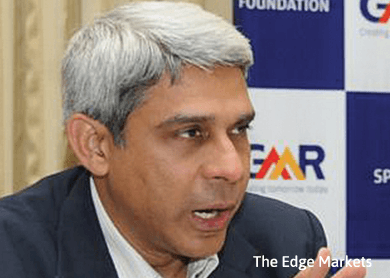
KUALA LUMPUR: GMR Hyderabad International Airport Ltd (Ghial), in which Malaysia Airports Holdings Bhd (MAHB) has a 11% equity interest, may see an earnings recovery as the airport operator has appealed to the Indian government to reverse its decision to scrap the user development fee (UDF) at the Rajiv Ghandi International Airport (RGIA) in Hyderabad, India.

GMR Group president and chief finance officer for airports Sidharath Kapur (pic) said that the cancellation of the UDF by the Airports Economic Regulatory Authority effective from April 2014 until March 31, 2016 had impacted the group significantly, but it is in the process of rectifying it.
“It (the policy) has impacted the group significantly. It is in the process of rectifying [the policy]. It has gone to the High Court, to ask the government to come out clearly on what they want. We expect a positive outcome in a short period of time,” Sidharath told The Edge Financial Daily in an interview at the Global Airport Development Asia 2015 conference hosted by MAHB recently.
For the financial year ended March 2015 (FY15), the company lost 3.4 billion Indian rupees (RM200 million) in income from the UDF. The company recorded a net loss of 1.18 billion rupees compared to a profit of 379 million rupees in FY14. Its aeronautical revenue, mainly from airport services, dropped to 798 million rupees from 4.23 billion rupees in FY14.
On the performance of the RGIA, Sidharath said the airport is doing very well in terms of operation and profitability. “There have been a few regulatory challenges, which have been resolved for now, and we should be in a position to revert to the earlier position of profitability,” he said.
The RGIA was operated by Ghial, a joint venture between the GMR Group (63%) in partnership with the Government of India (13%), the Government of Andhra Pradesh (13%) and MAHB (11%).
This is one of MAHB’s ventures in India, apart from its investment in the Delhi International Airport Pte Ltd (Dial) in which it divested its entire 10% stake to GMR Group for RM293 million.
MAHB managing director Datuk Badlisham Ghazali said that the airport in Hyderabad still has room to grow.
“It is a smaller airport, less than 15 million [passenger capacity], the opportunity from a growth rate perspective is higher, capital expenditure is also lower than Delhi Airport,” Badlisham said.
Commenting on the reason for MAHB’s divestment of the Dial stake, Badlisham said MAHB had minority stakes in the airport and the opportunity to grow beyond 10% was limited.
“On the other hand, most of the value had already been captured, as far as we are concerned, in our participation. The valuation was good. It is time to exit to focus our attention on other opportunities,” he said.
In 2006, Dial was MAHB’s first venture to India on the invitation of the GMR Group to be part of the airport privatisation venture.
Badlisham said that apart from looking at opportunities in airport projects, the group will continue to bid for service management contracts.
MAHB unit, Malaysia Airports Consultancy Services Middle East LLC, has secured a RM23.58 million contract at the New Doha International Airport (NDIA) in Qatar to provide facility management services for the NDIA project office, NDIA mock-up warehouse and associated facilities at the NDIA steering committee project office in Doha.
On May 5, MAHB announced that it was recently pre-qualified for the service contract to provide facilities management services to an airport in Jeddah, Saudi Arabia.
“We continue to look at services contracts. There are a few on the table,” Badlisham said, but he did not elaborate.
He said MAHB would continue to look at high-growth countries such as India and Indonesia for investment.
“And for the Middle East, we will see what services contracts we get, even here in Asia as well,” Badlisham said.
MAHB’s shares closed 10 sen or 1.6% higher at RM6.34 last Friday, giving it a market capitalisation of RM10.31 billion.
This article first appeared in The Edge Financial Daily, on June 15, 2015.